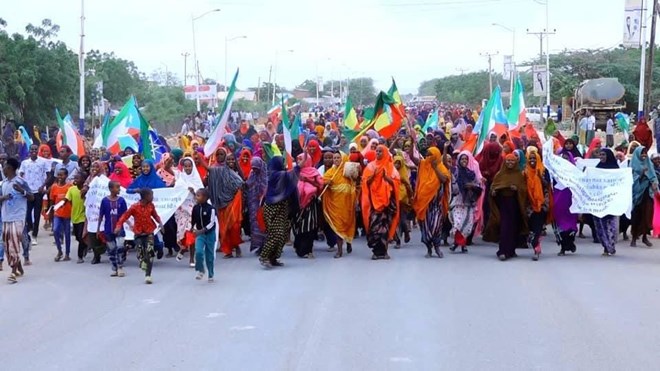Ethiopia Insight
Abel Tesfaye
Wednesday April 5, 2023
Constitution-based federal mediation must address persistent clashes over disputed land on the Djibouti trade corridor.

The deadly protest on 27 March in the Aysha district of Sitti Zone in Somali region highlights once more the recurring conflict between Somali and Afar states in Ethiopia.
The territorial dispute that instigated the protest revolves around Adaytu Kebele of Mille Wereda, Undufo Kebele in Gewane Wereda, and Gedamaytu Kebele in Amibara Wereda. Formally, they’re located, respectively, within Afar zones 1 and 3 and in Somali’s Sitti Zone.
The protest, which reportedly led to the death of three, was said to have erupted as a result of the national army’s response to protesters from the Issa clan who had blocked the Ethio-Djibouti highway.
Reports on 30 March indicated that the conflict had escalated into a multifrontal engagement between Afar and Somali militants near the road.
Somali CauseThe protesters were originally objecting to perceived federal support for the Afar security forces in the border dispute.
The Congress for Somali Cause (CSC), a Jigjiga based political movement advocating for Somali interests, accused the federal government of providing “tacit support to Afar militia” and expressed its fear of a repeat of the Ayisha massacre 60 years ago. It called on the federal government to bring the perpetrators to justice.
This incident is part of a larger struggle that has been simmering for years, with sporadic clashes between security forces and militias from the two regions occurring over land.
Conflict Roots
The disputed areas contain important resources, including the Awash river, and the highway and railway between Addis Abeba and Djibouti, which both Afar and Somalis need for their livestock and other trading.
Conflict over these resources has increased since 2018, with major clashes occurring in the context of heightened tensions during the run-up to the delayed national elections in 2021.
According to Ethiopia expert John Markakis in a publication about the conflict back in 2003, the struggle over the Awash river has historical roots, with the Afar being pushed northwards by their Somali Issa neighbors since the colonial period.
The allocation of land and political power based on ethno-federalism in 1991 further divided communities. Violence has since expanded beyond disputed locations and is fought by formal and informal militias.
Failed Agreements
In 2014, an agreement was signed between the two regions handing the disputed territories to Afar while granting the Somali residents political autonomy as “special kebeles”.
However, that deal failed to resolve the conflict, as Somali region withdrew from the agreement in May 2019. Moreover, Issa clan elders continue to oppose the arrangement and demand integration into Somali region.
The conflict reignited in March 2021 after the National Electoral Board of Ethiopia listed 30 polling stations in the disputed areas under the Somali region. Afar’s government disputed the decision, leading to the removal of the stations.
In turn, the Somali government rejected this and warned of the “difficulties of participating in the upcoming election” if the polling stations remained closed.
Persistent Suspicions
Somali residents have expressed concerns that the federal government is supporting Afar, which had been a federal ally in the military campaign in Tigray from 2020-22.
The Sitti Diaspora Community, a Brussels-based group, claims that the covert motive underpinning the federal support is to expel the Issa from the vicinity of the Djibouti-Addis Ababa thoroughfare, thereby ending Somalis’ grip over Ethiopia’s main trade conduit. This agenda is said to have been pursued by previous regimes and remains in effect.
The alleged excessive use of force on 27 March by the national army will not dampen such Somali fears.
Competing actors, including the federal government, Eritrea, Tigray, Amhara, and Oromo nationalists, and external actors like Djibouti, could leverage the Sitti conflict to advance their interests.
External Action
The federal government, for example, needs Afar support to help keep commercial traffic flowing to Djibouti and so they do not provide support to any current or potential opponents, such as Eritrean forces, the TPLF, the Oromo Liberation Army and Amhara militia.
Djibouti is dominated by the Afar and the Issa, and so their traditional leaders have a strong influence on the country’s politicians, including President Ismail Omar Guelleh.
TPLF, which historically had strong political and security ties in both Afar and Somali regions, was rumored to have fanned the Issa-Afar conflict during its dispute with the federal government as part of efforts to disrupt trade on the Djibouti-Addis highway.
Now, the embitterment over Sitti could also be used by allied Eritrean and Amhara interests to try and sway Somali elements to their side.
Lasting Solution
In terms of the land dispute, Issa Somalis claim that their clan constitutes a majority in the area, making the transfer to Afar unconstitutional. What is evident is that constitutional processes, including a referendum, were not adhered to in the 2014 federally mediated settlement.
This, coupled with the seemingly federal government-sanctioned forceful takeover of Western Tigray by Amhara forces in 2020, sets a dangerous precedent for trying to settle border disputes between regional states, which are present across the country.1
The May 2019 withdrawal of the Somali government from the 2014 settlement demonstrates that the ambiguous and informal agreement did not lead to a lasting solution.
This time around the federal government therefore needs to devise a better researched and constitutional approach to resolving the conflict.